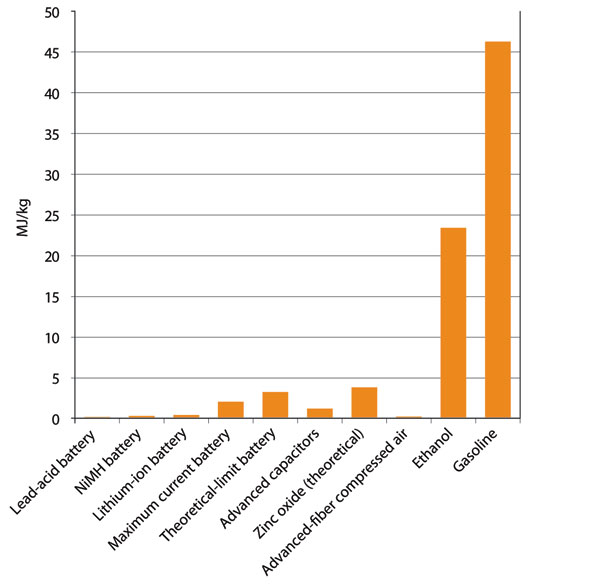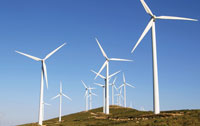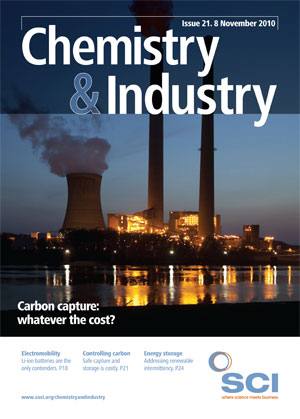By 2020, the EU has set itself the goal of generating 20% of the region’s total energy requirements, and 35% of total electricity generation, from renewable energy sources. Although the US has no national target, California is aiming for 33% renewables in the electricity grid by 2020, while 29 other states have also set renewable energy targets.

A key approach to evening out the impact of intermittency is energy storage – the development of technologies that can store energy generated during periods of good wind and sun for use at other times. Many approaches have been proposed and tested, including compressed-air storage, batteries, and the use of molten salts in solar-thermal plants (Box 1). However, the major drawbacks of all these approaches include the losses involved in energy storage and release, and the limited energy density (Figure 1 and Box 2) that current storage technologies can achieve.
How to manage the intermittency of renewable energy remains a thorny problem. On the one hand, there are those who claim that we can significantly increase renewable energy integration into existing systems by increasing capacity and long-distance transmission links between locations with renewable generation and those with base-load generation. ‘Smart grid’ controls and software, which have only begun to be introduced, are expected to give this approach a boost, but large-scale deployment is a number of years away.
Currently, Denmark has achieved its high – about 18% of generation – penetration of wind into its grid thanks to its interconnections with the hydro-based Norwegian system. China is looking to manage the penetration of its wind capacity by linking it with high-voltage direct current (HVDC) connections to its substantial hydropower capacity in south-west China. In the US, many schemes have been proposed for connecting western wind capacity with the coal-fired capacity of the Mid- West. The EU plan is similar: build out extensive long-distance HVDC connections from Norway, around Ireland and the UK, through Europe, and from North Africa, where it is proposed to generate solar power for Europe. Such schemes could potentially reduce the need for energy storage; however, they all are capital and resource-intensive and require high levels of maintenance.
An alternative view is one of distributed generation, in which local resources and smaller scale generation schemes are favoured over the large centralised grid. This includes both fossil generation – through gas turbines, fuel cells and combined heat and power (CHP) – along with photovoltaics (PV) and wind, integrated into smaller local grid that can increase reliability by being ‘islanded’ from the larger grid. Such schemes would also require storage, which would be larger proportionally and would also depend on the local source of base-load generation. The often-heard proposal to use every electric vehicle’s battery as a way to store electricity is consistent with this distributed generation framework – though the technology to do this has yet to be tested.
Another potential source of energy savings is demand shedding and demand management. It is widely understood, though not widely accepted, that our assumption that power should be available in whatever quantity needed at whatever time we want it is not consistent with a world of higher penetration of intermittent renewable energy. There will be the need, under either the macro or micro schemes above, for consumers simply to reduce their use of energy when renewable generation falters from weather or other events.
Both of the first two approaches above are highly path-dependent. If we, as a society, choose to go one way, it will not be not easy, or even possible, to alter course at a later date since we will have locked ourselves into a huge asset investment.
Of all the schemes for energy storage, meanwhile, only pumped hydro storage currently has any significant capacity in either the US or in the EU. In the US, according to the Energy Information Administration (EIA), there is 21.5GW of pumped storage out of 962GW of total generation capacity, or about 2.2% of the total. For the EU, Eurostat shows that there is a total of 38.3GW of pumped storage capacity, out of a total system capacity of about 700GW, or about 5%.

Hydro is key to renewable energy integration schemes both in northern Europe as well as in the Pacific Northwest of the US. In Washington state, for example, the current hydro capacity is sufficient to buffer the intermittency of about 9 GW of wind power capacity. Beyond that, other approaches would be needed.
Intermittency and low capacity factors for wind and solar will always make them less ‘competitive’ with fossil fuels in the sense that these energy sources will require infrastructure investment to fulfil the expectation of the electricity grid, which is to provide electricity whenever you want it. Storage technologies will also increase the cost of renewable electricity, but will contribute to smoothing out their intermittency. These costs are likely to be underestimated; although generation costs have fallen over the past few decades, system costs are likely to rise.
Real-time storage will be increasingly needed, and those who are most successful in creating effective storage technologies and schemes are likely to be financially rewarded for their efforts. The business opportunity is likely to be larger at the smaller scale than the macro national scale, since current technologies are already well known, and newly developed technologies are unlikely to reach anything near commercial scale for another 15-20 years. The ‘ultimate battery’ is everyone's holy grail, but this is largely in the context of electric vehicles. Storage will be needed without question, but physics limits the effectiveness of these technologies, particularly compared with the ‘storage’ of ancient sunlight by Nature in the creation of fossil fuels.
Energy storage options compared
Current energy storage systems each have advantages and limitations.
- Pumped storage has an efficiency of between 70-85%, but it is also capital and land intensive. It is only appropriate in certain geographical locations.
- Compressed air energy storage is low efficiency, in the 35-50% range, but there are few of these schemes – one in Germany and one in Alabama, US. This is also highly geography-limited, since an appropriate underground cavern is needed that can handle the pressures and temperatures of compressed air.
- Flywheel energy storage has the potential of achieving up to 90% efficiency, but is not suitable for large-scale, long-duration storage; it is best used when demand is needed quickly and in short periods of minutes or hours.
- Batteries can achieve 80% efficiency, but suffer from very low energy density, and thus large resource consumption.
- Capacitors can also be used for fast deliver of power for short periods.
- Molten materials, such as salts, at concentrated solar thermal power plants can also extend generation for a period beyond sundown. However, this would not allow 24-hour generation.
Energy density – a history
Aside from alleviating a growing wood shortage, the conversion to the use of coal in the 17th and 18th centuries was welcomed because coal provided twice as much energy as wood for the same weight of material. Similarly, the shift from coal- to petroleum-powered ships in the early 20th century was driven by the fact that petroleum possesses nearly twice the energy density of coal, allowing ships to go farther without having to stop for refuelling. Even when used in a motor vehicle’s inefficient internal combustion engine, a kilogram of highly energy-dense gasoline— about six cups—allows us to move 3,000lb of metal about 11 miles.
The consequence of low energy density is that larger amounts of material or resources are needed to provide the same amount of energy as a denser material or fuel. Many alternative energies and storage technologies are characterised by low energy densities, and their deployment will result in higher levels of resource consumption.
As shown in Figure 1, the main alternatives under development to supplant gasoline use in cars are dramatically lower in energy density than gasoline itself. Lithium-ion batteries—the focus of current research for electric vehicles—contain only 0.5 MJ/kg of battery, compared with 46MJ/kg for gasoline. Advances in battery technology are being announced regularly, but they all come up against the theoretical limit of battery density of only 3MJ/kg.
David Fridley is the Renewable Energy Biofuels Fellow for the Post Carbon Institute as well as deputy group leader and scientist at Lawrence Berkeley’s China Energy Group in California, US. A full copy of his recent report Nine challenges of alternative energy can be obtained at: http://www.postcarbon.org/report/127153-energynine- challenges-of-alternative-energy





